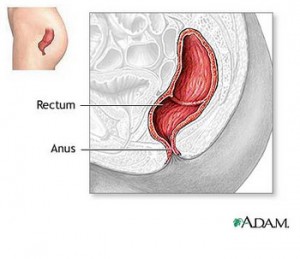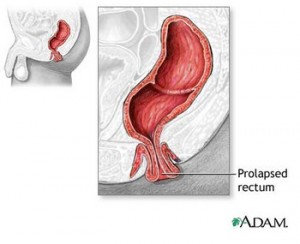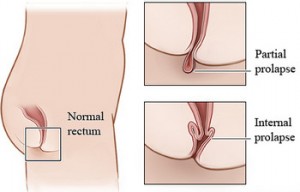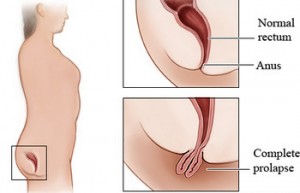What is Rectal Prolapse?
Rectal Prolapse is a condition occurring when the rectum which is the lowest intestinal section, loses internal support and slips outside the body. Symptoms are many and this condition occurs in older adults – normally women and in some cases in young children. Rectal prolapse in infants may be a sign of cystic fibrosis.
Rectal Prolapse Symptoms
Symptoms of rectal prolapse include some of the following:
- Constipation
- Cystic fibrosis
- Fecal incontinence
- Feeling a bulge or protrusion thru the anus
- Anal bleeding
The major symptom is a reddish colored mass that can stick out from the anal opening, especially following bowel movements. The lining of the rectal tissue might be visible as well as may slightly bleed.
Rectal Prolapse Pictures
Picture 1 : Normal Rectum
Picture 2 : Prolapsed Rectum
Picture 3 : Partial rectal prolapse and internal rectal prolapse
Picture 4 : Complete Rectal prolapse
Rectal Prolapse Causes
Prolapse of the rectum develops most normally in those children under the age of 6 and in the elderly. It is often linked with the following conditions:
- Constipation
- Pinworms also known as enterobiasis
- Cystic fibrosis
- Malabsorption and malnutrition for instance celiac disease
- Previous injury to the anus or pelvic area
- Advancing age
- Chronic constipation
- Chronic straining during defecation
- Chronic diarrhea
- Pregnancy
- Childbirth stresses
- Prior surgery
- COPD
- Sphincter paralysis
Rectal Prolapse Treatment
Contact your primary care physician if a rectal prolapse occurs. In many cases, the problem can be treated at home.
The rectal mucosa needs to be return manually to the rectum. A warm, soft wet cloth is used to apply the gentle pressure on the mass in order to push it back thru the anal opening. The person affected needs to be in a knee-chest position before applying any pressure in order to allow gravity to aid in returning the prolapse.
In the early stages of this condition, rectal prolapse may be treated with suppositories, stool softeners as well as other medications. Immediate surgery for repair is seldom needed as the underlying condition needs to be treated first.
In most individuals treating the underlying condition normally cures this problem. But in elderly patients who have had repeated prolapse, surgery can be needed to repair any physical problems which might likely occur.
Rectal Prolapse Surgery and Repair
Rectal prolapse surgery is the process used to repair this condition. This surgery normally relieves distress as well as lessens fecal incontinence in the majority of individuals with this problem.
There are several methods of performing this surgery. The surgeon will recommend the surgical approach that is appropriate and is based on the health as well as the type of condition. The surgery is normally completed under anesthesia that is general and necessitates a hospital stay for a small number of days.
Prolapse surgery does carry some risk as all surgery does. But in this case there is a risk of severe problems. Every different technique for the repair of prolapse carries its own risk. But generally prolapse surgery risks may include:
- Obstruction of the bowel
- Bleeding
- Infection
- Damage to structures nearby, such as organs as well as nerves
- Rectal narrowing
- Constipation that worsens
- Rectal prolapse that recurs
In preparing for surgery, your physician might request that you:
Shower using a special soap. This shower using antibacterial soap is needed before surgery in order to help prevent any germs on the skin from creating an infection.
Consume a fluid drink to cleanse the intestines. This is a drink that will flush food and any stools from the rectum and colon in the days prior to surgery.
Stop any drugs. Dependent on the procedure the physician can ask you to stop some of your regular medications.
The individual will need to plan ahead for the days spent in the hospital in order to be as comfy as probable during the stay. Things that the patient should consider bringing:
- Personal items such as toothbrush or shaving articles
- Clothes that are comfortable, for instance slippers as well as robe
- Some entertainment, for instance games or books
There are several types of prolapse surgery and these include:
Repair thru the anus. This method is often referred to as “perineal rectosigmoidectomy”. In the course of this method, the surgeon will remove a share of the rectum and then stitch the remaining rectum to the colon.
The method for surgery may be done by means of regional anesthesia so that the patient remains awake. This tactic generally has a much smaller risk of any complications and will also mean less days in the hospital. But, there are some concerns that this method does carry a high risk of prolapse recurrence.
Repair thru the abdomen. This method of surgery may also be done by making an abdominal incision. With this procedure, often called rectopexy, the physician will pull the rectum back into the body and then secure the rectum to the tissue surrounding the sacrum which is the structure that is bony and is above the tailbone and below the spine. The surgeon fortifies the rectum with either a sling that is made of mesh and supports the rectum or with sutures. In some situation, the surgeon can remove a part of the colon in a process that is called resection rectopexy.
This approach to prolapse surgery needs general anesthesia to put the individual to sleep, and unaware during the surgery. This abdominal method has a greater risk of problems, but evidence does suggest that the prolapse may be much less likely to reoccur with this method.
Repair by minimally invasive surgery. This method of surgery is done using several very smaller incisions in the abdomen. The procedure is often called a laparoscopic rectal prolapse surgery. The surgeon will insert special surgical tools as well as a tiny camera thru the incisions to repair the prolapse.
This method requires general anesthesia. But the minimal invasion can reduce the risk of complications and speeds recovery time although it is not suitable for everyone.




